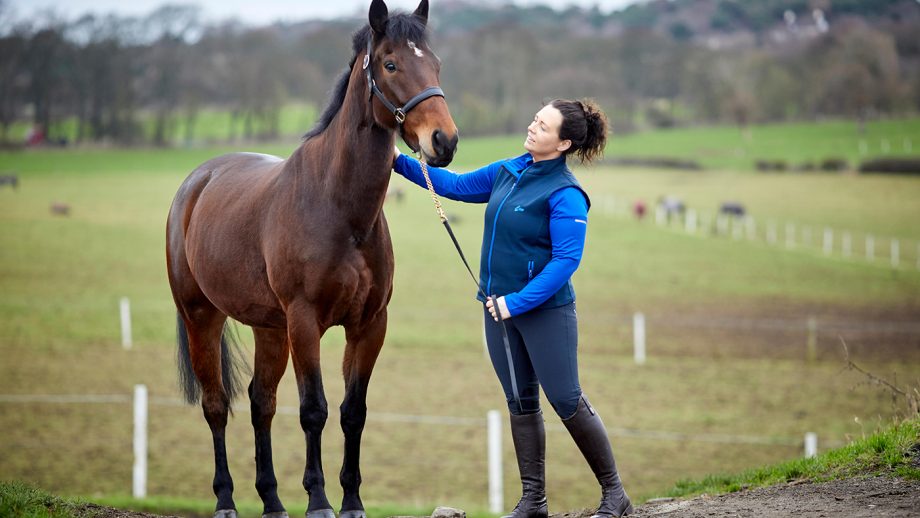A pre-purchase examination can throw up a number of issues to consider before buying a horse, but the vet can help the potential purchaser weigh up the results...
Few horses tick all the boxes when it comes to health and temperament; a degree of compromise must usually be made.
Experts agree that a five-stage pre-purchase examination (PPE) is a sound investment before buying, rather than the shortened two-stage exam, but how does a vet assess a horse with an obvious or suspected problem? And how does a potential purchaser weigh up the findings to make their decision?
Lesley Barwise-Munro MRCVS and Malcolm Morley MRCVS discuss three typical scenarios…
Safe and sound?
This horse has a good competition record, but doubts have been raised about his behaviour. Is it the vet’s responsibility to protect a buyer from being over-horsed?
{"content":"PHA+4oCcVGhlIFBQRSBjZW50cmVzIGFyb3VuZCBhIHZldGVyaW5hcnkgY2hlY2sgbGlzdCwgYnV0IGF0IHRoZSBzYW1lIHRpbWUgb2JzZXJ2YXRpb25zIGFyZSB1c3VhbGx5IG1hZGUgYWJvdXQgdGhlIGhvcnNl4oCZcyBiZWhhdmlvdXIgYW5kIHN1aXRhYmlsaXR5IHRvIHByb3RlY3QgdGhlIGJ1eWVyLOKAnSBzYXlzIExlc2xleS4g4oCcV2hhdCBpcyBjb25zaWRlcmVkIGFjY2VwdGFibGUgaXMgdmVyeSBtdWNoIGRyaXZlbiBieSB0aGUgbGV2ZWwgYW5kIGV4cGVyaWVuY2Ugb2YgdGhlIGJ1eWVyLCB0aGUgcHJvc3BlY3RpdmUgcmlkZXIgYW5kIHRoZSBob3JzZeKAmXMgZnV0dXJlIGpvYi48L3A+CjxwPjxkaXYgY2xhc3M9ImFkLWNvbnRhaW5lciBhZC1jb250YWluZXItLW1vYmlsZSI+PGRpdiBpZD0icG9zdC1pbmxpbmUtMiIgY2xhc3M9ImlwYy1hZHZlcnQiPjwvZGl2PjwvZGl2PjxzZWN0aW9uIGlkPSJlbWJlZF9jb2RlLTMxIiBjbGFzcz0iaGlkZGVuLW1kIGhpZGRlbi1sZyBzLWNvbnRhaW5lciBzdGlja3ktYW5jaG9yIGhpZGUtd2lkZ2V0LXRpdGxlIHdpZGdldF9lbWJlZF9jb2RlIHByZW1pdW1faW5saW5lXzIiPjxzZWN0aW9uIGNsYXNzPSJzLWNvbnRhaW5lciBsaXN0aW5nLS1zaW5nbGUgbGlzdGluZy0tc2luZ2xlLXNoYXJldGhyb3VnaCBpbWFnZS1hc3BlY3QtbGFuZHNjYXBlIGRlZmF1bHQgc2hhcmV0aHJvdWdoLWFkIHNoYXJldGhyb3VnaC1hZC1oaWRkZW4iPg0KICA8ZGl2IGNsYXNzPSJzLWNvbnRhaW5lcl9faW5uZXIiPg0KICAgIDx1bD4NCiAgICAgIDxsaSBpZD0ibmF0aXZlLWNvbnRlbnQtbW9iaWxlIiBjbGFzcz0ibGlzdGluZy1pdGVtIj4NCiAgICAgIDwvbGk+DQogICAgPC91bD4NCiAgPC9kaXY+DQo8L3NlY3Rpb24+PC9zZWN0aW9uPjwvcD4KPHA+4oCcQmVpbmcgaGVhZCBzaHksIGJhcmd5IG9yIHNoYXJwIGluIHRlcm1zIG9mIHRocmVhdGVuaW5nIHRvIGtpY2sgY2FuIGJlIHJldmVhbGVkIGR1cmluZyB0aGUgZWFybHkgc3RhZ2VzIG9mIHRoZSBQUEUuIFRoZSB2ZXQgbXVzdCB0cnkgdG8gYXNjZXJ0YWluIGlmIHRoZSBob3JzZSBpcyBqdXN0IGEgd29ycmllciBhbmQgc2xvd2x5IHNldHRsZXMsIG9yIGlmIGhlIGhhcyBhIHRlbXBlcmFtZW50IGlzc3VlIHRoYXQgY291bGQgYWZmZWN0IHN1aXRhYmlsaXR5IOKAkyBiZWZvcmUgZGVzY3JpYmluZyB3aGF0IGhhcyBoYXBwZW5lZCBhbmQgYWxlcnRpbmcgdGhlIGJ1eWVycyB0byBzZWUgaWYgdGhlIGlzc3VlIGNvbmNlcm5lZCB0aGVtIHdoZW4gdGhleSB0cmllZCBoaW0uPC9wPgo8cD7igJxBIGhvcnNlIHdpdGggYSB0ZW5kZW5jeSB0byBuYXAgbWF5IG5vdCBwcm9kdWNlIHRoaXMgb24gdGhlIGRheSBvZiB0aGUgZXhhbS4gQXMgYSBidXllciwgaXQgaXMgYWx3YXlzIHdvcnRoIGFza2luZyB0byByaWRlIHRoZSBob3JzZSBhd2F5IGZyb20gb3RoZXJzIHdoZW4geW91IHRyeSBoaW0sIGFuZCwgaWYgcG9zc2libGUsIGhhY2tpbmcgaGltIG91dCBhbG9uZS48L3A+CjxwPuKAnEFzIHRoZSBQUEUgcHJvZ3Jlc3NlcywgYSB2ZXQgd2lsbCBnZXQgYSBmZWVsIGZvciBhIGhvcnNlIGluIHRlcm1zIG9mIGhpcyBtYW5uZXIgYW5kIGJlaGF2aW91ci4gV2F0Y2hpbmcgdGhlIGhvcnNlIG92ZXIgdGhlIHN0YWJsZSBkb29yIHdoaWxlIGZpbGxpbmcgaW4gdGhlIGluaXRpYWwgcGFwZXJ3b3JrIG1heSByZXZlYWwgYW55IGFibm9ybWFsIGJlaGF2aW91cmFsIHRyYWl0cyBzdWNoIGFzIHdlYXZpbmcsIGJveCB3YWxraW5nIG9yIHdpbmQgc3Vja2luZy48L3A+CjxkaXYgY2xhc3M9ImFkLWNvbnRhaW5lciBhZC1jb250YWluZXItLW1vYmlsZSI+PGRpdiBpZD0icG9zdC1pbmxpbmUtMyIgY2xhc3M9ImlwYy1hZHZlcnQiPjwvZGl2PjwvZGl2Pgo8cD7igJxLZWVwIGluIG1pbmQgdGhhdCBhbiBleHBlcmllbmNlZCBoYW5kbGVyIG9yIHJpZGVyIHByZXNlbnRpbmcgYSBob3JzZSBmb3Igc2FsZSBjYW4gZGlzZ3Vpc2UgaXNzdWVzLiBCbG9vZCBzYW1wbGluZyBhdCBQUEUgaXMgYSBzYWZlZ3VhcmQgdG8gZmFsbCBiYWNrIG9uIGlmIGl0IGlzIHN1c3BlY3RlZCB0aGF0IGRydWcgYWRtaW5pc3RyYXRpb24gaGFzIGJlZW4gdXNlZCB0byBtb2RpZnkgYmVoYXZpb3VyLiBSZW1lbWJlciwgdG9vLCB0aGF0IHlvdSBtYXkgbm90IGJlIGFibGUgdG8gcmlkZSBhIGhvcnNlIGluIHRoZSBzYW1lIHdheSBhcyBhIHByb2Zlc3Npb25hbCBhbmQgcHJvZHVjZSB0aGUgc2FtZSByZXN1bHRzIGF0IGhvbWU7IHN1cHBvcnQgZnJvbSBhIGdvb2QgdHJhaW5lciBpcyB3b3J0aCBwdXR0aW5nIGluIHBsYWNlLjwvcD4KPHA+4oCcVWx0aW1hdGVseSwgdGhlIHZldCBjYW4gb25seSBhZHZpc2UgYWJvdXQgdGVtcGVyYW1lbnQsIHNvIHRoYXQgYXQgbGVhc3QgYW55IHBvdGVudGlhbCBuYXVnaHRpbmVzcyBpcyBmbGFnZ2VkIHVwLuKAnTwvcD4KPGRpdiBjbGFzcz0iYWQtY29udGFpbmVyIGFkLWNvbnRhaW5lci0tbW9iaWxlIj48ZGl2IGlkPSJwb3N0LWlubGluZS00IiBjbGFzcz0iaXBjLWFkdmVydCI+PC9kaXY+PC9kaXY+CjxoMz5Xb25reSwgYnV0IG90aGVyd2lzZSB3b25kZXJmdWw8L2gzPgo8cD5IZSBzZWVtcyBzb3VuZCBhbmQgc2Vuc2libGUgYnV0IHRoaXMgaG9yc2UgaGFzIGlzIG5vdGljZWFibHkgYXN5bW1ldHJpY2FsLiBXaGF0IHNob3VsZCBhIHBvdGVudGlhbCBidXllciBjb25zaWRlcj88L3A+CjxwPkxlc2xleSBleHBsYWluczog4oCcQXMgcGFydCBvZiBhIFBQRSwgdGhlIGhvcnNlIHNob3VsZCBiZSBzdG9vZCBvbiBhIGZpcm0sIGxldmVsIHN1cmZhY2Ugc28gdGhhdCB0aGUgdmV0IGNhbiBjYXJyeSBvdXQgYSBkaXN0YW50IGFwcHJhaXNhbCBvZiBoaXMgb3ZlcmFsbCBjb25mb3JtYXRpb24g4oCTIGZyb20gdGhlIGZyb250LCBzaWRlIGFuZCBiZWhpbmQuPC9wPgo8ZGl2IGNsYXNzPSJhZC1jb250YWluZXIgYWQtY29udGFpbmVyLS1tb2JpbGUiPjxkaXYgaWQ9InBvc3QtaW5saW5lLTUiIGNsYXNzPSJpcGMtYWR2ZXJ0Ij48L2Rpdj48L2Rpdj4KPHA+4oCcVGhlIGhpbmQgZmVldCBzaG91bGQgYmUgdG9nZXRoZXIgYXMgaGUgaXMgdmlld2VkIGZyb20gYmVoaW5kLCBzbyB0aGUgdmV0IGNhbiBhc3Nlc3MgcGVsdmljIHN5bW1ldHJ5IGJ5IGxvb2tpbmcgZm9yIGhlaWdodCBkaWZmZXJlbmNlcyBvZiB0aGUgdHViZXIgc2FjcmFsZSAob3IgVFMsIHRoZSBib255IHByb21pbmVuY2VzIGF0IHRoZSB0b3Agb2YgdGhlIGhpbmRxdWFydGVycykuIFBhbHBhdGlvbiBvZiB0aGUgVFMgaGVscHMgY29uZmlybSBsZXZlbG5lc3Mgb3IgaWRlbnRpZnkgYW55IHNtYWxsIGRpZmZlcmVuY2VzLiBWaWV3aW5nIGZyb20gYmVoaW5kIGFsc28gYWxsb3dzIGFzc2Vzc21lbnQgb2YgbXVzY2xlIHN5bW1ldHJ5LCBoaWdobGlnaHRpbmcgYW55IHN3ZWxsaW5ncyBhbmQgd2hldGhlciBvbmUgaGluZCBsaW1iIGlzIHJvdGF0ZWQgbW9yZSB0aGFuIHRoZSBvdGhlci48L3A+CjxwPuKAnEZyb20gdGhlIGZyb250LCB0aGUgc2hhcGUgb2YgYm90aCBzaWRlcyBvZiB0aGUgbmVjaywgdGhlIHNob3VsZGVyIG11c2NsaW5nLCBmcm9udCBsaW1iIHJvdGF0aW9uICh0b2UgaW4gb3IgdG9lIG91dCkgYW5kIHRoZSBzaXplIGFuZCBzaGFwZSBvZiB0aGUgZnJvbnQgZmVldCBhcmUgYXNzZXNzZWQsIGFuZCB0aGUgZmV0bG9ja3MgYW5kIGtuZWVzIGNoZWNrZWQgZm9yIGJlaW5nIGFuIGVxdWFsIGhlaWdodCBmcm9tIHRoZSBncm91bmQuPC9wPgo8cD7igJxXaHkgaXMgc3ltbWV0cnkgc28gaW1wb3J0YW50PyBUaGUgcmVsYXRpb25zaGlwIGJldHdlZW4gY29uZm9ybWF0aW9uIOKAkyBlc3BlY2lhbGx5IG9mIHRoZSBsb3dlciBsaW1icyDigJMgYW5kIGxhbWVuZXNzIGlzIHdlbGwgcmVjb2duaXNlZC4gSG9yc2VzIGNvbWUgaW4gYWxsIHNoYXBlcywgc2l6ZXMgYW5kIHR5cGVzLCBzbyBjb25mb3JtYXRpb24gd2lsbCB2YXJ5LCBidXQgY2VydGFpbiBjb25mb3JtYXRpb24gZmF1bHRzIHByb2R1Y2UgcHJlZGljdGFibGUgcHJvYmxlbXMuPC9wPgo8cD7igJxTaW5jZSBiaW9tZWNoYW5pY2FsIGVmZmljaWVuY3kgb2YgbW92ZW1lbnQgaXMgdGhvdWdodCB0byBzdGVtIGZyb20gZ29vZCwgc3ltbWV0cmljYWwgY29uZm9ybWF0aW9uLCBjb3JyZWN0IG1vdmVtZW50IHdpbGwgY3JlYXRlIHRoZSBsZWFzdCBhbW91bnQgb2YgYWJub3JtYWwgc3RyYWluLiBUaGUgbW9yZSBkZWdyZWVzIGF3YXkgZnJvbSDigJxwZXJmZWN04oCdIGNvbmZvcm1hdGlvbiwgdGhlIGdyZWF0ZXIgdGhlIHN0cmFpbiBvciDigJx0b3JxdWXigJ0gaW4gdGhlIGFmZmVjdGVkIHBhcnRzIG9mIHRoZSBib2R5LjwvcD4KPHA+4oCcVGhpcyBpcyBhbGwgcHJvcG9ydGlvbmFsIHRvIHRoZSBsZXZlbCBvZiB3b3JrIHRoYXQgdGhlIG5ldyBob3JzZSB3aWxsIGJlIGV4cGVjdGVkIHRvIGRvLiBUaGUgaGlnaGVyIHRoZSBsZXZlbCBvZiBwZXJmb3JtYW5jZSBpbiBlYWNoIGRpc2NpcGxpbmUsIHRoZSBtb3JlIGVtcGhhc2lzIGlzIHB1dCBvbiBiZWluZyBhcyBjbG9zZSB0byB0aGUg4oCcZ29sZCBzdGFuZGFyZOKAnSBzeW1tZXRyaWNhbCBjb25mb3JtYXRpb24gYXMgcG9zc2libGUuIFdoaWxlIGl0IGlzIGltcG9ydGFudCB0byByZWNvZ25pc2UgZGVzaXJhYmxlIGNvbmZvcm1hdGlvbmFsIHRyYWl0cyBpbiBob3JzZXMgc3VpdGVkIHRvIGEgcGFydGljdWxhciBkaXNjaXBsaW5lLCBob3dldmVyLCBhIHZldCBtdXN0IGFsc28gbGVhcm4gdG8gb3Zlcmxvb2sgYSBtaW5vciBmYXVsdCB0aGF0IGhhcyBsaXR0bGUgY2xpbmljYWwgcmVsZXZhbmNlLjwvcD4KPHA+4oCcQWZ0ZXIgYSB2aXN1YWwgYXNzZXNzbWVudCBvZiB0aGUgY29uZm9ybWF0aW9uIGFuZCBhbnkgbHVtcHMgb3IgYnVtcHMsIHRoZSB2ZXQgd2lsbCB3YXRjaCB0aGUgaG9yc2UgbW92ZSB0byBldmFsdWF0ZSB0aGUgaW1wYWN0IG9mIGFueSBsaW1iIGRldmlhdGlvbnMgb3IgYXN5bW1ldHJpZXMuIFdoZXJlIG9uZSBmb3JlbGltYiDigJx0b2VzIGlu4oCdIG1vcmUgdGhhbiB0aGUgb3RoZXIsIGZvciBleGFtcGxlLCB0aGF0IGxlZyB3aWxsIGhhdmUgYSBkaWZmZXJlbnQgZmxpZ2h0IHBhdGggYW5kIGxhbmQgb24gdGhlIG91dHNpZGUgb2YgdGhlIGZvb3Qg4oCTIGNhdXNpbmcgdW5ldmVuIGxvYWRpbmcgd2hpY2ggdHJhbnNtaXRzIHRocm91Z2ggYWxsIHJlbGF0ZWQgam9pbnRzLiBHb29kIGZhcnJpZXJ5IG1heSByZWN0aWZ5IHRoZSBwcm9ibGVtLCBhbGxvd2luZyB0aGUgZm9vdCB0byBsYW5kIGZsYXQgYW5kIHByb3RlY3QgdGhlIGNvZmZpbiBqb2ludCwgbmF2aWN1bGFyIGFwcGFyYXR1cywgZmV0bG9jayBqb2ludHMgYW5kIHJlbGF0ZWQgc29mdCB0aXNzdWUgc3RydWN0dXJlcyBpbiB0aGF0IGxlZy48L3A+CjxwPuKAnEEgZGlmZmVyZW5jZSBpbiBUSSBoZWlnaHRzIGlzIHRoZSBtb3N0IGNvbW1vbiBwZWx2aWMgYXN5bW1ldHJ5IGRldGVjdGVkIGF0IFBQRS4gVGhpcyBpcyBvZnRlbiBwcmVzdW1lZCB0byBiZSBzdWJsdXhhdGlvbiAocGFydGlhbCBkaXNsb2NhdGlvbikgb2YgdGhlIHNhY3JvaWxpYWMgKFNJKSBqb2ludCwgYnV0IGl0IG1heSBhbHNvIGJlIGNhdXNlZCBieSBhc3ltbWV0cmljYWwgbXVzY2xlIGZvcmNlcyBhY3Rpbmcgb24gdGhlIHBlbHZpcywgcmF0aGVyIHRoYW4gZGlyZWN0IFNJIGxpZ2FtZW50IGluanVyeS4gT25seSBhIGZldyBvZiB0aGVzZSBob3JzZXMgYWN0dWFsbHkgaGF2ZSBwYXRob2xvZ3kgb2YgdGhlIFNJIGxpZ2FtZW50IG9yIFNJIGpvaW50IGxheGl0eS48L3A+CjxwPuKAnFN0dWRpZXMgaGF2ZSByZXZlYWxlZCwgaG93ZXZlciwgdGhhdCBUUyBoZWlnaHQgYXN5bW1ldHJpZXMgb2YgbW9yZSB0aGFuIDFjbSBhcmUgb2Z0ZW4gYXNzb2NpYXRlZCB3aXRoIHBvb3IgcGVyZm9ybWFuY2UgYW5kIHNob3VsZCBiZSBzY3J1dGluaXNlZCBjYXJlZnVsbHkgZm9yIFNJIHBhaW4gb24gcGFscGF0aW9uLCBoaW5kbGltYiBsYW1lbmVzcyBhbmQgYmFjayBzdGlmZm5lc3MuPC9wPgo8cD7igJxBcyB3aXRoIGFueSBvdGhlciBhc3ltbWV0cmllcywgdGhpcyBhYm5vcm1hbGl0eSwgaWYgZGV0ZWN0ZWQsIG11c3QgYmUgY2FyZWZ1bGx5IGludGVycHJldGVkLiBJcyBpdCBsaWtlbHkgdG8gYWZmZWN0IHRoZSBob3JzZeKAmXMgcGVyZm9ybWFuY2UgZm9yIHRoZSBwdXJwb3NlIGZvciB3aGljaCBoZSBpcyBiZWluZyBwdXJjaGFzZWQ\/IFRoZSB2ZXQgc2hvdWxkIGdpdmUgYW4gb3BpbmlvbiBvZiB3aGV0aGVyIHRoZSBob3JzZSBpcyBjdXJyZW50bHkgc291bmQgaW4gYWxsIGFzcGVjdHMgb2YgdGhlIFBQRSBhbmQgbGlrZWx5IHRvIHN0YW5kIHVwIHRvIGhpcyBpbnRlbmRlZCBqb2IsIGFzIHdlbGwgYXMgZGlzY3Vzc2luZyBhbnkgaW1wbGljYXRpb25zIGZvciByZXNhbGUgdmFsdWUu4oCdPC9wPgo8aDM+TWFpbnRhaW5lZCBvbiBtZWRpY2F0aW9uPC9oMz4KPHA+VGhlIG9jY2FzaW9uYWwgam9pbnQgaW5qZWN0aW9uIGtlZXBzIHRoaXMgaG9yc2UgcGVyZm9ybWluZyBhdCBoaXMgYmVzdC4gSXMgaGUgYSB3aXNlIGJ1eT88L3A+CjxwPuKAnEl0IGlzIG5vdCB1bmNvbW1vbiB0aGF0IGFuIG9sZGVyIHNjaG9vbG1hc3RlciBob3JzZSB3aG8gaGFzIGhhZCBhIHN1Y2Nlc3NmdWwgY29tcGV0aXRpb24gY2FyZWVyIGlzIG5vdCBlbnRpcmVseSBzb3VuZCB3aXRob3V0IG1lZGljYXRpb24sIHN1Y2ggYXMgcmVndWxhciBwaGVueWxidXRhem9uZSAoa25vd24gYXMg4oCcYnV0ZeKAnSkgb3Igam9pbnQgaW5qZWN0aW9ucyzigJ0gc2F5cyBNYWxjb2xtLiDigJxBcyBwYXJ0IG9mIHRoZSBQUEUsIHRoZSBzZWxsZXIgc2lnbnMgYSBmb3JtIGRlY2xhcmluZyB3aGV0aGVyIHRoZSBob3JzZSBoYXMgcmVjZWl2ZWQgYW55IG1lZGljYXRpb24gd2l0aGluIHRoZSBsYXN0IDMwIGRheXMuIFdoaWxlIHdlIHdvdWxkIHByZWZlciB0byBleGFtaW5lIHRoZSB1bm1lZGljYXRlZCBob3JzZSwgaXQgaXMgbm90IG5lY2Vzc2FyaWx5IGEgcHJvYmxlbSBpZiBoZSBoYXMgcmVjZWl2ZWQgc29tZXRoaW5nIOKAkyBwcm92aWRlZCB0aGF0IHRoZSBzZWxsZXIgZGVjbGFyZXMgdGhpcyBhbmQgdGhlIHBvdGVudGlhbCBwdXJjaGFzZXIgaXMgbWFkZSBhd2FyZS48L3A+CjxwPuKAnFNvbWUgYnV5ZXJzIGZlZWwgdGhhdCBpdOKAmXMgbm90IHdvcnRoIGludmVzdGluZyBpbiBhIFBQRSB3aXRoIGEgaG9yc2Ugb24gbWVkaWNhdGlvbiBhcyB0aGV5IGtub3cgaXQgd2lsbCDigJxmYWls4oCdLCBidXQgdGhpcyBpcyBtaXNzaW5nIHRoZSBwb2ludCBvZiB0aGUgZXhhbS4gVGhlIFBQRSBpcyBkZXNpZ25lZCB0byBkbyBzbyBtdWNoIG1vcmU7IGJ5IGxvb2tpbmcgYXQgdGhlIGJpZ2dlciBwaWN0dXJlLCB0aGUgdmV0IGNhbiBvZmZlciBhIGJhbGFuY2VkIG9waW5pb24gb2YgdGhlIGhvcnNl4oCZcyBzdWl0YWJpbGl0eSBmb3IgaW50ZW5kZWQgdXNlLiBXaGF04oCZcyBpbXBvcnRhbnQgaXMgdG8gdXNlIGEgdmV0IHdobyBrbm93cyB5b3UgYW5kIHlvdXIgdmFsdWVzLCBhbmQgdmljZSB2ZXJzYS48L3A+CjxkaXYgY2xhc3M9ImluamVjdGlvbiI+PC9kaXY+CjxwPuKAnE1hbnkgb2YgdGhlc2Ugc2Nob29sbWFzdGVycyBzdGlsbCBoYXZlIHNvIG11Y2ggdG8gb2ZmZXIuIENvbnNpZGVyIHRoZSBpbXBsaWNhdGlvbnMsIHN1Y2ggYXMgb25nb2luZyBjb3N0cyBhbmQgcG90ZW50aWFsIGluc3VyYW5jZSBpc3N1ZXMsIGJ1dCBkb27igJl0IHJ1bGUgb3V0IGJ1eWluZyBhIGhvcnNlIHRoYXQgcmVxdWlyZXMgbWVkaWNhdGlvbiBpZiBoZSBzZWVtcyBvdGhlcndpc2Ugc3VpdGFibGUu4oCdPC9wPgo8aDM+VGhlIHZldHM8L2gzPgo8cD5MRVNMRVkgQkFSV0lTRS1NVU5STyBNUkNWUyBvdmVyc2VlcyBhIGJ1c3kgY2FzZWxvYWQgb2YgcGVyZm9ybWFuY2UgYW5kIGxlaXN1cmUgaG9yc2VzIGF0IEFsbm9ydGh1bWJyaWEgVmV0ZXJpbmFyeSBHcm91cCwgTm9ydGh1bWJlcmxhbmQuPC9wPgo8cD5NQUxDT0xNIE1PUkxFWSBNUkNWUywgb2YgU3RhYmxlIENsb3NlIEVxdWluZSBQcmFjdGljZSwgSGFtcHNoaXJlLCBoYXMgY2hhaXJlZCB0aGUgQnJpdGlzaCBFcXVlc3RyaWFuIFZldGVyaW5hcnkgQXNzb2NpYXRpb24gKEJFVkEpIFBQRSBjb21taXR0ZWUuPC9wPgo8cD48ZW0+UmVmOiAyOCBKYW51YXJ5IDIwMjE8L2VtPjwvcD4KPHA+Cg=="}
You might also be interested in…





